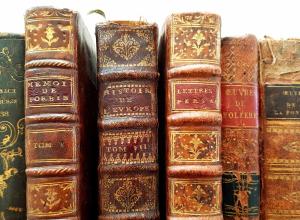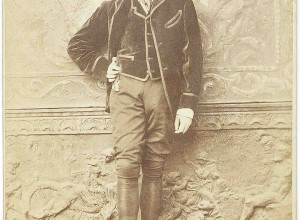Bright Young Booksellers: Abby Schoolman
 Our Bright Young Booksellers series continues today with Abby Schoolman, proprietor of Abby Schoolman Books in New York City:
Our Bright Young Booksellers series continues today with Abby Schoolman, proprietor of Abby Schoolman Books in New York City:
How did you get started in rare books and the book arts?
I had the great luck to have grown up in a house full of readers with a very wide range of interests: art from ancient Egypt to Red Grooms, mystery novels, poetry, world religions, American history. Being surrounded by prints by 20th century artists such as Bernard Buffet and Marc Chagall, antique maps, and contemporary Inuit art didn't hurt. My parents were always willing to take me and my sister to the library and to bookstores. I remember that when I was about 12 or 13, I told my sister I wanted to run a bookstore when I grew up, not that I knew what that entailed. Around the same time, I created a card catalog of my dad's collection of golden age mysteries and spy novels which were double- and triple-shelved. We kept buying duplicates. In high school, like most people in the trade, I stumbled across 84, Charing Cross Road. But the real truth is that my interest in rare books and book arts was entirely accidental.
At my alma mater, Wellesley College, you have to declare your major at the end of your third term. For three terms I had reveled in a beautiful tossed salad of courses and still had no idea what I wanted to do. I decided to read the entire college course catalog and mark everything that sounded remotely interesting. Surely, I thought, I will find enough classes in a single department to fulfill the minimum requirement for a major. I didn't. At the very end of the catalog there was a note about interdisciplinary majors and a list of those that were pre-approved by the faculty. Bingo! I had marked something like 16 classes that fell within Medieval/Renaissance Studies, a deliciously vague and inclusive course of study. I officially had a license to be an academic dilettante.
What I soon discovered was that the thread connecting my academic choices was an interest in the history of the book. I learned about everything from Books of Hours to the Kelmscott Press. Twice I tried, without success, to get a job in the college's surprisingly comprehensive Special Collections Department, with holdings, just in printed books, ranging from a first edition of Hypnerotomachia Poliphili to contemporary artists' books.
After college, I went to library school in Boston. I was trained as an archivist and rare book librarian. In early 2000, while working for a historical society in New York, I was recruited by Bauman Rare Books to work in its then brand new Madison Avenue gallery. I jumped at the chance. For over 14 years, I worked with five centuries of the most interesting and beautiful books in almost every field of human thought. It was heaven. The only type of book I rarely encountered was the type I work with now, but contemporary bookbinding interested me.
A few days before I started working for Bauman Rare Books, I stumbled across an exhibit of contemporary bindings of books on angling at the American Museum of Natural History. For the first time in my life, I bought an exhibition catalog. Little did I know that, many years later, buying books and catalogs of contemporary bookbinding exhibits from the mid-20th century to the present would become my obsession.
Around 2005, a concatenation of events caused me to become the manager of a massive contemporary bookbinding project. The seed that had been sown at the exhibit at AMNH blossomed. The bookbinder with whom I worked for over eight years was incredibly patient and generous in sharing many aspects of the world of bookbinding with me. I learned so much from him. As far as I know, he is still working on that never-ending project.
When did you open Abby Schoolman Books and what do you specialize in?
I opened Abby Schoolman Books in August 2014. I focus on unique contemporary art bookbindings and artist's books of exceptional creativity and quality. I represent five incredibly talented artists exclusively. Whatever they make, in whatever format, I will sell. I also include in my inventory a number of specially selected books by other talented bookbinders and book artists. The bindings are always unique. The other books range from unique to limited edition fine press books.
Tell us about your role as a book artist representative. How does that work?
I love working directly with my artists: Malina Belcheva (US), Mark Cockram (UK), Timothy C. Ely (US), Christine Giard (France), and Sonya Sheats (US). Mostly, I stay out of their way. I want them to make whatever they want, in whatever format or medium they choose, regardless of what they have made or sold in the past. The freedom to choose, and the freedom from the constraints of set book competitions, juried exhibitions, and traditional expectations allows the artists breathing space. The result is better art.
My role as agent and bookseller for my five principal artists varies greatly based on individual needs or projects. Sometimes I am a sounding board for ideas, sometimes I am a student learning about structure or technique or obscure bookbinder lore, sometimes I gently give deadlines by providing a list of dates of upcoming book and art fairs. For some I write or edit documents. I also try to hustle on the behalf of those artists who wish to line up commissions, lectures, workshops, or other gigs. Often I listen to their ideas for bookselling: some of my artists have been in the book business for far longer than I, though from a different angle. Working a book fair with Christine Giard or Mark Cockram is an eye-opening experience for each of us. Most of all, what I do is try promote each artist and everything they do as loudly and comprehensively as possible, whether or not it relates directly to selling a book I have in stock.
What do you love about the book arts and the rare book trade?
I love working with living artists. It is a treat to watch their work come alive and to discuss books, art, and craftsmanship with them. The tradition of collegiality and the depth of knowledge in the rare book trade is incredible. Especially in contemporary book arts, the knowledge and experience of other dealers is a precious resource which most are happy to share. I was recently accepted as a member of the Antiquarian Booksellers' Association of America. It is a great honor to be a part of the best in the trade.
Describe a typical day for you:
I don't really have a set schedule. I usually start around 7:30, in bed, with breakfast, news, and email. That portion of the day can last for hours. Of course, there are customer visits (by appointment) and shipping. My artists are in several time zones, so my work day has a way of breaking up into strange chunks according to their schedules. If I'm not working with a customer and one of them wants to talk, they get my full attention. I spend much of my time researching, writing, and wrangling the large numbers of images required to showcase each book.
Favorite rare book (or ephemera; or book art) that you've handled?
Timothy Ely's unique manuscript and binding Bones of the Book: An Oblong Identity is a masterpiece. There is simply no other way to look at it. It's physically huge (44.5cm x 30cm x 3.5cm), very personal and, even for Ely, incredibly complex in scope. It is special in many ways, not least because it took him 25 years to complete it. The title page says 1990 and it was exhibited then, I believe at Granary Books. He didn't sell it. He put it away. Sometimes he showed it, but the truth is that it just didn't feel finished to him. In 2015, he removed the original binding (now in the Ely archives), worked a bit more on the original pages, and rebound the book. It is now truly complete and it is spectacular.
Bones of the Book is the second in a three-book series that differs significantly from Ely's other art. These books are both biographical and autobiographical. Each honors the important influence of family members in Ely's life, and combines it with an aspect of bookbinding--the format Ely has chosen to house his artwork throughout his career. In each case, there is also a third narrative that plays a significant role in Ely's identity as an individual and as an artist.
The series began with Binding the Book: The Flight Into Egypt in 1985. Egypt is about Ely's grandfather, the journal he left behind about his mysterious trip to Egypt between the wars, bookbinding, and the geography of Egypt. For much more information about Binding the Book: The Flight Into Egypt, see The Flight into Egypt: Binding the Book (Chronicle Books, 1995). It's out of print, but there are often copies available on Abebooks.
In Bones of the Book, the visual narrative combines Ely's origins (Snohomish, WA, his parents, and their hardware store), and the close relationship between book structure and human anatomy. The third book has yet to be made. Ely plans for it to be about his Uncle Jack and his work as a combat photographer in the Pacific during WWII. In addition to the three-fold, co-mingled story line in Bones, as in all of Ely's art, there are layers of references drawn from alchemy, mathematics, mythology, geography, and geology.
What do you personally collect?
Bookbinders. Also, books and exhibit catalogs of contemporary art bookbinding for my reference collection. Rob Fleck at Oak Knoll is my crack dealer and he knows it. In other words, I don't collect. If I did, it would be what I sell.
What do you like to do outside of work?
There is an "outside of work?" Ok. I'll admit that I like to knit, sleep, and hang out with my husband and our hilarious 12 year old daughter. When I have time, I try to keep my blog American Bound active. I also have an affection for police procedurals, both books and on television.
Thoughts on the present state and/or future of the book arts field:
The term "book art" encompasses an enormous amount of material produced these days. Even the definition of "book" is up for grabs. "Book arts" is a useful term, but lacks specificity. There is a very large, enthusiastic, international community of book makers of various sorts, from the kitchen table hobbyist to highly trained, ingenious artists. Many of those book makers are also collectors. I try not to be rigid about my definition of "book." I am aware of my biases, but don't mind being challenged. Still, I try to focus on my favorite things: art bookbinding and unique (or very limited edition) artist's books. I want to see exceptional craftsmanship, creativity, and intelligence. I feel very good about the work of the very talented artists who use the book as their primary format for expression. Finding and showcasing a great binder or book artist is wonderful and, unlike the traditional art market, even their greatest works are affordable compared to a work by a contemporary painter of comparable stature. Book collectors know that and they know a good thing when they see it.
Any upcoming fairs or catalogues?
I'm excited about exhibiting at the ABAA California Antiquarian Book Fair in Oakland, February 10 - 12.
Image courtesy Abby Schoolman.















